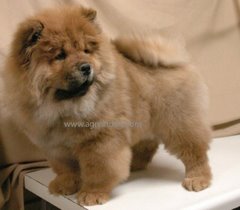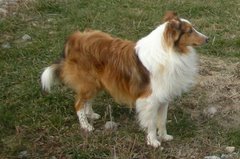Did You Know Dogs Blush Too?
“Man is the only animal that blushes -- or needs to.” Mark Twain
How special does that make us?
Not very! The Pharaoh Hound and Ibizan both blush. Both breeds, when happy or
excited are suffused with a rosy glow, from the tips of the ears all the way to the noses.
Granted, the dogs aren't likely to have nearly as many varying reasons to turn red as we
do, but that's hardly something for us to brag about.
The question is, do they ever blush from embarrassment brought on by our actions?
Maybe all those times when our dogs have waited until we're bragging on something
about their behavior and they choose that moment to make liars of us is just payback
being, well, appropriately, a bitch.
Possibly the next time your boss drops by the house and your faithful sidekick waits
until the silence wrapped around your total concentration on how best to begin to
explain your next radiantly intelligent, innovative proposal -- the one that is going to
score that promotion and whopping raise -- is complete to let one of those silent but
deadly stench bombs loose, the kind that, because they're quiet, no one ever quite
believes that story “the dog did it,” it's payback for those photos you took of your dog
with a funny hat tied to his head. If your dog could blush to express those feelings he
might not be forced to seek vengeance.
Another breed with an unusual capacity generally thought to be reserved for humans is
the Basenji. The breed that yodels. It might be argued by some that listening to a
Basenji yodeling is a shade more pleasant to hear than a human yodeling, Jewel and
her disturbing ability to yodel in reverse notwithstanding.
Thankfully, there's not a clogging dog -- that we know of yet, anyway.
If you believe in coincidence, it's an odd one that these breeds all strongly resemble
pictures and carvings of the Tesem dogs found on stelae and in tombs of ancient Egypt,
as do the Pharaonenhund. The descriptions are strikingly similar: the pricked ears,
lithe, muscular body, forehead wrinkles, coloration. The Basenji tail is typically held
more tightly curled over the back, although when running it is usually held out straight
behind the dog, adding balance. The Pharaoh Hound's tail may be held curled over the
back or relaxed.
But evidence and what limited knowledge we have gleaned to date from our DNA
research into the origins of dogs points to the conclusion that the dogs of the type
Pharaonenhund are indigenous to the island of Malta and did not, in fact, have their
origins in Egypt as so many wish to believe and the nomenclature used by registries
“Pharaoh Hound” infers.
If you don't believe in coincidence, the similarities between the dogs are fascinating and
lead to speculation as to what future DNA research into canine origins will reveal.
Current studies are fairly limited, both by our still growing understanding of genetics and
by the extremely small pool of breeds and examples of those breeds whose DNA has
been entered into the databases being used. Archaeology has long pointed to the Dark
Continent as one of the most likely cradles of the human species and even today the
diversity of creatures found there is staggering. It isn't a great leap to suppose that a
primary branch on the family tree of canis lupus familiarus has its origins there as well. It
would be only fitting, as homosapiens and canis l. familiarus have walked through time
together for many ages.
After all, as they say, “men are dogs.”
Brought to you by Susan Handwell of www.pet-super-store.com; where you can get Dog Beds as well as Dog Doors
Wednesday, July 22, 2009
Monday, July 13, 2009
Importance of dehydration
Dehydration in Dogs
Dehydration is a problem facing dogs often ignored or forgotten until it occurs. People overlook this simple fact. The bodies of dogs, like those of humans consist primarily of water. In fact, 2/3rds of a dog’s body is composed of water. Water is an essential part of their nature. A dog can survive far longer without food than water. A dehydrated dog slips quickly towards serious physical problems, including organ failure and death.
Causal factors of dehydration vary. While it all boils down to a lack of water, with its electrolytes, within the system, the problem may be direct or indirect. You may forget to fill the water bowl. On a hot day, this can prove uncomfortable or fatal. Dehydration can result in death. A solution may be to use a water bowl capable of dispensing water regularly. Also, be sure the dog is not able to knock it over easily. Consider heavier ceramic bowls. Check regularly and maintain more than one bowl if your dog is particularly clumsy.
Fever is also the cause of dehydration in your pet. If your dog is sick, it may require more water. Like people, animals with a fever need more fluids. Increase the fluid content and cool the animal down with damp or wet cloths – perhaps even a cool bath. Concentrate on the head and underbelly areas. Pay heed to signs of dehydration and note what your Vet has to say about a dog with a fever.
If you give the dog water, be careful. A dehydrated dog, or one moving in that direction, should not have too much to drink. While the distressed canine needs water and electrolytes quickly, if you give too much, too soon, your dog will vomit. This increases the process of dehydration. Instead, give it small amounts over a period of time. If possible, provide it with a form of electrolytes. Some stores have a form for babies. This is a feasible substitute.
If your dog has severe diarrhea or urinates excessively, it may become dehydrated. Dogs can get “the runs” without it being necessary to take to the vet. An upset stomach, eating something new or different or gas can cause the animal to excrete more than usual. This purges their system of the problem. It also removes water from the body. The dog needs to replace it. If this situation occurs, make sure there is sufficient water available.
Vomiting also can reduce the amount of bodily fluids necessary to keep the body running smoothly. The dog in up chucking his meal once is not at risk. If this happens repeatedly, call your vet. Make sure the dog has access to water. He or she will need it to prevent dehydration setting in. A vet can and will put him on a drip if and when necessary.
The signs of dehydration are obvious ones. They include sunken eyes and a loss of appetite. Your dog is listless. He or she suffers from exhaustion. The pet looks depressed. She or he has a dry mouth and nose. What clearly indicates dehydration is the condition of the skin. When you pull it away from the body, it takes longer to flatten back into place – more than 3 seconds.
If your dog suffers from dehydration, do not monkey around. Contact the vet while making getting him or her to drink small amounts of water. Cool your dog down with wet cloths. Make him or her comfortable then rush to the vet. Better still, avoid this scenario. Make sure your animal always has enough clear, clean, fresh cold water to drink.
Content written by Rebecca Garcia – for more dog information by Rebecca, check out additional topics on dog carriers & dog training information.
Dehydration is a problem facing dogs often ignored or forgotten until it occurs. People overlook this simple fact. The bodies of dogs, like those of humans consist primarily of water. In fact, 2/3rds of a dog’s body is composed of water. Water is an essential part of their nature. A dog can survive far longer without food than water. A dehydrated dog slips quickly towards serious physical problems, including organ failure and death.
Causal factors of dehydration vary. While it all boils down to a lack of water, with its electrolytes, within the system, the problem may be direct or indirect. You may forget to fill the water bowl. On a hot day, this can prove uncomfortable or fatal. Dehydration can result in death. A solution may be to use a water bowl capable of dispensing water regularly. Also, be sure the dog is not able to knock it over easily. Consider heavier ceramic bowls. Check regularly and maintain more than one bowl if your dog is particularly clumsy.
Fever is also the cause of dehydration in your pet. If your dog is sick, it may require more water. Like people, animals with a fever need more fluids. Increase the fluid content and cool the animal down with damp or wet cloths – perhaps even a cool bath. Concentrate on the head and underbelly areas. Pay heed to signs of dehydration and note what your Vet has to say about a dog with a fever.
If you give the dog water, be careful. A dehydrated dog, or one moving in that direction, should not have too much to drink. While the distressed canine needs water and electrolytes quickly, if you give too much, too soon, your dog will vomit. This increases the process of dehydration. Instead, give it small amounts over a period of time. If possible, provide it with a form of electrolytes. Some stores have a form for babies. This is a feasible substitute.
If your dog has severe diarrhea or urinates excessively, it may become dehydrated. Dogs can get “the runs” without it being necessary to take to the vet. An upset stomach, eating something new or different or gas can cause the animal to excrete more than usual. This purges their system of the problem. It also removes water from the body. The dog needs to replace it. If this situation occurs, make sure there is sufficient water available.
Vomiting also can reduce the amount of bodily fluids necessary to keep the body running smoothly. The dog in up chucking his meal once is not at risk. If this happens repeatedly, call your vet. Make sure the dog has access to water. He or she will need it to prevent dehydration setting in. A vet can and will put him on a drip if and when necessary.
The signs of dehydration are obvious ones. They include sunken eyes and a loss of appetite. Your dog is listless. He or she suffers from exhaustion. The pet looks depressed. She or he has a dry mouth and nose. What clearly indicates dehydration is the condition of the skin. When you pull it away from the body, it takes longer to flatten back into place – more than 3 seconds.
If your dog suffers from dehydration, do not monkey around. Contact the vet while making getting him or her to drink small amounts of water. Cool your dog down with wet cloths. Make him or her comfortable then rush to the vet. Better still, avoid this scenario. Make sure your animal always has enough clear, clean, fresh cold water to drink.
Content written by Rebecca Garcia – for more dog information by Rebecca, check out additional topics on dog carriers & dog training information.
Friday, September 21, 2007
Why Dogs Bite
Why do Dogs Bite?The underlying reason dogs bite is to assert their authority.When they are first born, deaf blind, and premature, their only scent is smell. They smell mother and are totally dependent on her for warmth and nutrition. As the little ones mature, their sight and hearing develops and they become more independent. They learn at an early age that there is competition (other puppies) and they themselves are quite selfish, ie, would take all mothers milk and let siblings starve. Mother will monitor this and correct that behavior. She does this by biting them gently in the neck. This immediately signals the puppy to go into submission and the behavior is corrected. They recognize the mother as their supreme leader and the boss and will follow her each and every wish. As the pups mature and are weaned from mother, they are looking for a new leader. This must be a strong person that sets rules and boundaries with authority and the dog will happily comply with those and live a happy life. If the dog is not given rules and boundaries, it will take it upon itself to make the rules and it will become the supreme leader by default. It will enforce its rule by biting, just as Mother did. The key here is to never let the dog think it is #1. Humans always #1, dogs #2. Humans walk ahead of the dog, not the dog ahead of human. Human goes through the door first, dog follows. Human decides when to eat , when to play and when to give affection. Affection > always given in a calm submissive state. Exercise, disciple, then affection. For additional discussion on this consider viewing a book by Cesar Milan, the Dog Whisperer
Posted by Burgs at 7:33 AM
Monday, July 9, 2007
How to potty train a puppy
How to potty train a puppy.
Most dogs by nature are quite clean and will never soil in their perceived area unless given no other choice. The trick is for both you and your puppy to get on the same page as to what their perceived area is. If given too much area, such as run of the whole house, the dog by nature will make its own boundaries within that house and go potty where it feels it is not significant to bother him.
I recommend restricting a new puppy's boundaries whenever it cannot be 100% supervised or tended to. This is easily accomplished by using a crate. Put them outside first briefly and then in their restricted boundary, until you again can supervise and play with them. Whenever you put them in the crate and take them out, you should let them try to go potty. When they do go potty outside, praise and a special flavored treat are a good thing and the puppy quickly associated this with going potty and special attention. If they do not go potty outside, they should go back into their restricted boundary and not taken out to be played with for a few moments, then try again outside for another potty trip.
Also, the outside potty area should be restricted. It should not be a big play area, but a potty area. If too big, the puppy will play and forget to go potty and when brought back into the house go there. The puppy should only be in the potty area a short time and not left. If they do not make use of the potty time, they should go back in the crate without praise or a treat. Soon they will learn to get things done quickly and then on to treat and playtime.
As the puppy matures and becomes more used to the routine, the boundaries can be increased and finally eliminated. Hope this helps,
Most dogs by nature are quite clean and will never soil in their perceived area unless given no other choice. The trick is for both you and your puppy to get on the same page as to what their perceived area is. If given too much area, such as run of the whole house, the dog by nature will make its own boundaries within that house and go potty where it feels it is not significant to bother him.
I recommend restricting a new puppy's boundaries whenever it cannot be 100% supervised or tended to. This is easily accomplished by using a crate. Put them outside first briefly and then in their restricted boundary, until you again can supervise and play with them. Whenever you put them in the crate and take them out, you should let them try to go potty. When they do go potty outside, praise and a special flavored treat are a good thing and the puppy quickly associated this with going potty and special attention. If they do not go potty outside, they should go back into their restricted boundary and not taken out to be played with for a few moments, then try again outside for another potty trip.
Also, the outside potty area should be restricted. It should not be a big play area, but a potty area. If too big, the puppy will play and forget to go potty and when brought back into the house go there. The puppy should only be in the potty area a short time and not left. If they do not make use of the potty time, they should go back in the crate without praise or a treat. Soon they will learn to get things done quickly and then on to treat and playtime.
As the puppy matures and becomes more used to the routine, the boundaries can be increased and finally eliminated. Hope this helps,
Subscribe to:
Comments (Atom)






